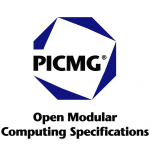
MicroTCA.0 Revision 3 released
Latest MicroTCA.0 Revision 3 adds high-bandwidth interfaces such as 100 GbE and PCIe Gen 5 with increased TDP to prepare the specification for demanding next-generation edge and server workloads and applications
WAKEFIELD, MA. PICMG, a leading consortium for the development of open embedded computing specifications, has ratified Revision 3.0 of the MicroTCA.0 (µTCA.0) specification. This new release addresses urgent bandwidth requirements by defining 100 GbE and PCIe Gen 5 fabrics that improve system performance by 4x while also expanding platform thermal design power (TDP), enabling the use of higher performance processors. Users can now select from a range of specification-compliant building blocks and solutions that allow for more power per slot for higher transfer rates within µTCA chassis and to external systems and server clusters. It also lays the foundation for building next-generation MicroTCA proofs of concept.
Revision 3 of MTCA.0 addresses the current and future demands of applications such as machine vision, AI, defense, research, instrumentation, wireless communication, and emerging applications like quantum computing. “Revision 3 of MTCA.0 addresses urgent requirements and thus enables companies to now provide specification-compliant solutions rather than proprietary or custom approaches,” says Heiko Korte of NAT Europe and lead of PICMG’s MicroTCA Technical Working Group. “The fact that so many MicroTCA ecosystem suppliers have joined the working group shows the importance of the changes and also underlines the strong interest to make these part of an open specification.
“The broad spectrum of participants also ensured that every single agenda item got reviewed from different angles and properly discussed,” he adds.
MicroTCA.0 Revision 3.0-compliant solutions will be available shortly, including chassis, MicroTCA Carrier Hub (MCH), Advanced Mezzanine Card (AMC), Rear Transition Module (RTM), and power modules (PM) products from VadaTech, NAT, AIES Sp z o.o., nVent SCHROFF, and others. The commitment of existing vendors to continuing the development of µTCA products is joined by increased interest from players in emerging fields like quantum computing, projecting a healthy lifecycle for the open computing specification for years to come.
“VadaTech is proud to have been part of the development and ratification of revision 3 of the uTCA specification,” says Alex Malcom, Managing Director of VadaTech Ltd. “Its release secures the continued adoption of the standard by commercial, scientific and defense organizations around the world.”
The MicroTCA.0 Revision 3.0 specification can be accessed at www.picmg.org/product/micro-telecommunications-computing-architecture-base-specification. For more information on the MicroTCA family, visit https://nateurope.com/technology/mtca-amc or https://www.picmg.org/openstandards/microtca.
About PICMG
Founded in 1994, PICMG is a not-for-profit 501(c) consortium of companies and organizations that collaboratively develop open standards for high performance industrial, Industrial IoT, military & aerospace, telecommunications, test & measurement, medical, and general-purpose embedded computing applications. There are over 130 member companies that specialize in a wide range of technical disciplines, including mechanical and thermal design, single board computer design, high-speed signaling design and analysis, networking expertise, backplane, and packaging design, power management, high availability software and comprehensive system management.
Key standards families developed by PICMG include COM-HPC, COM Express, CompactPCI, AdvancedTCA, MicroTCA, AdvancedMC, CompactPCI Serial, SHB Express, MicroSAM, and HPM (Hardware Platform Management). https://www.picmg.org.
New Partnership with Blue Line A/S

We are proud to announce our new partnership with Blue Line A/S representing N.A.T. in Scandinavia.
Blue Line, a Danish-based provider of industrial IT hardware designed for demanding environments having local offices in Sweden, Norway, and Finland, is dedicated to serving the Nordic region.
“This new partnership allows us to expand our product portfolio by incorporating widely implemented MicroTCA, VPX, and PMC/XMC solutions.”, said Niels Pedersen, Managing Director of BlueLine A/S. He continued: “ Additionally, it enables us to offer NAT's market-leading solutions across the Nordic region.”
Helmut Laufkoetter, Managing Director of N.A.T., added: “We warmly welcome Blue Line as our new partner. This new partnership allows us to meet the growing demands of the embedded market in all the Nordic countries and unlocks exciting new opportunities for team N.A.T..”
N.A.T. and Blue Line are looking forward to a very successful joint future in the Scandinavian markets.
Click the link below to discover more about Blue Line.
